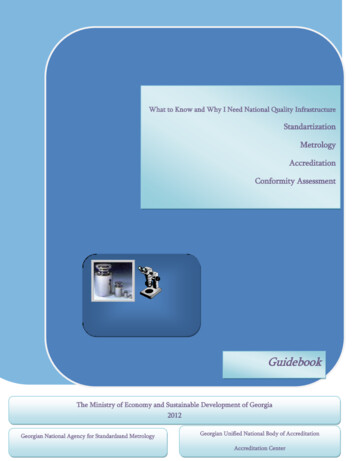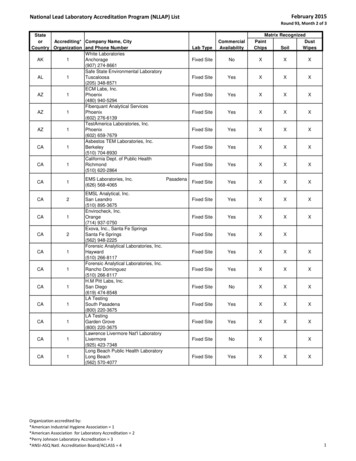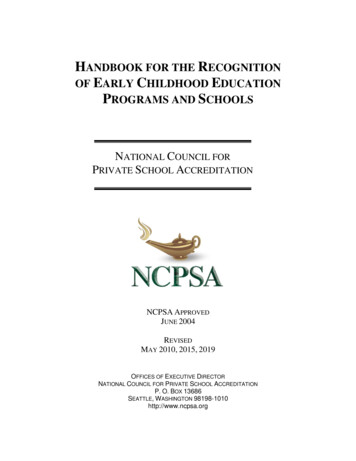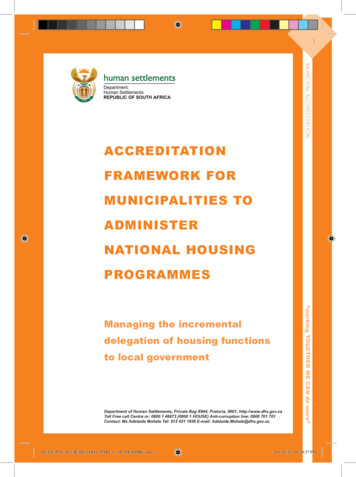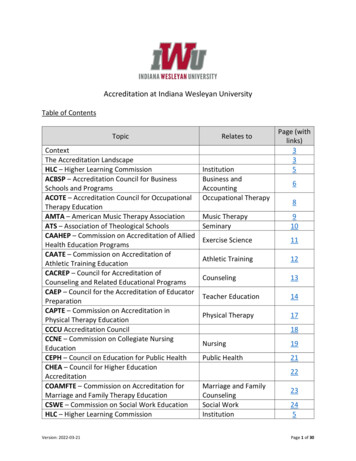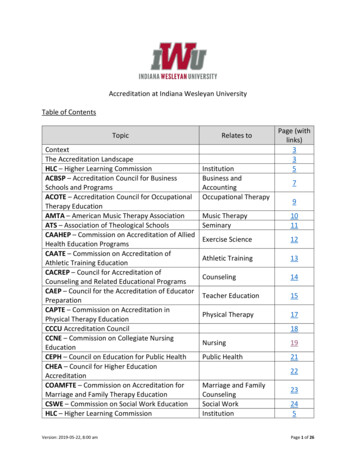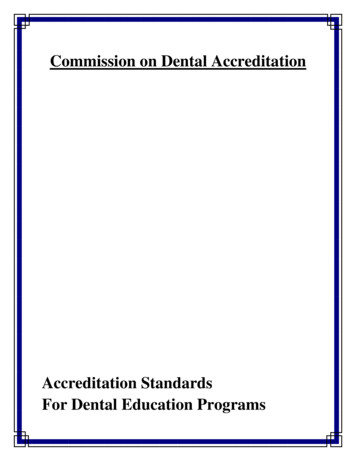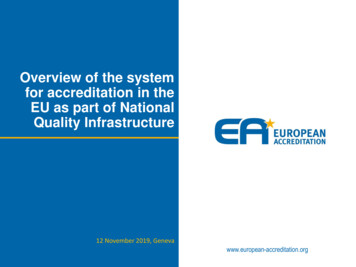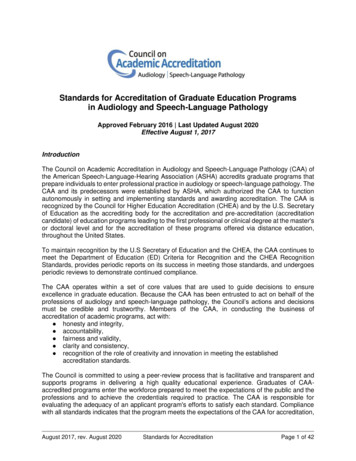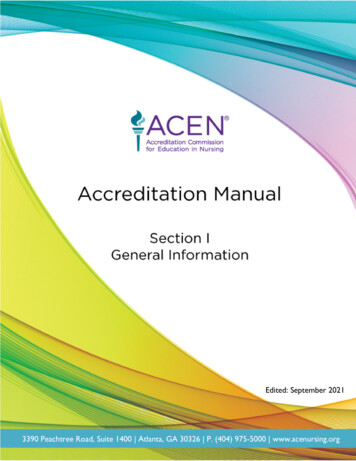
Transcription
ACCREDITATION STANDARDSANDSELF-STUDY HANDBOOK2021 StandardsFor Graduate ProgramsIn Healthcare Quality and Safetybased on theCriteria for AccreditationApproved May 15, 2020Revised October 2020Effective Fall 2021The completed Self-Study and accompanying documents are confidential, and the property of TheCommission on Accreditation of Healthcare Management Education (CAHME) and the hostUniversity. CAHME requests the agreement of the University to grant access to the Self-Study andaccompanying documents to bona fide scholars pursuing projects of potential value to graduateeducation when specific authority is granted from CAHME.
Self-Study Handbook 2021 HQS StandardsINTRODUCTIONCAHME’s mission is to advance the quality of healthcare management education, and accreditation is atthe core of that mission.Students look for CAHME-accredited programs as assurance that they will offer a high-qualityeducational experience that will best prepare them for leadership. Hospitals and health systems look tohire graduates of CAHME-accredited programs knowing that these new executives are coming to themnot just with academic credentials, but with proven competencies in meeting the challenges ofproviding healthcare in communities across the country and around the world.This Self-Study Handbook outlines the steps programs must take to achieving accreditation, or reaccreditation. The Handbook includes direction to programs on creating their Eligibility Statement andtheir Self-Study document. These documents, along with the CAHME Site Visit, are critical pieces in theaccreditation process for programs to demonstrate that they meet CAHME standards.Through accreditation, programs support CAHME’s mission to advance the quality of healthcaremanagement education. We appreciate your interest and are ready to answer any questions you mighthave about the process and about the benefits of accreditation for programs and students. You may alsofind more information on the CAHME web site, www.cahme.org.1
Self-Study Handbook 2021 HQS StandardsTable of ContentsINTRODUCTION . 1GENERAL INSTRUCTIONS . 3About the Eligibility Statement . 4About the Self-Study Submission . 4Basic Survey Questionnaire . 5Course-Related Materials and Other Program Documents . 5Completed Self-Study Format . 5Consultation with CAHME . 6Submission Deadlines . 6ELIGIBILITY STATEMENT . 6REQUIREMENT A . 6REQUIREMENT B. 7REQUIREMENT C. 7REQUIREMENT D . 7REQUIREMENT E . 8REQUIREMENT F . 8REQUIREMENT G . 9REQUIREMENT H . 9REQUIREMENT I . 9REQUIREMENT J . 9OVERVIEW OF THE PROGRAM . 10PROGRESS SINCE PREVIOUS SITE VISIT . 10CRITERION I: PROGRAM MISSION, VALUES, VISION, GOALS AND SUPPORT . 11I.A. Mission and Metrics . 11I.B. Institutional Support. 13CRITERION II: STUDENTS & GRADUATES. 16CRITERION III. COMPETENCIES, CURRICULUM & TEACHING AND LEARNING METHODS . 25III.A. Competencies and Curriculum Design . 25III.B. Teaching and Learning Methods . 31III.C. Assessment of Student Learning & Competency Assessment . 35III.D. Program Evaluation . 37CRITERION IV. FACULTY TEACHING, SCHOLARSHIP AND SERVICE . 38IV. A Qualifications and Responsibilities . 38IV.B. Research and Scholarship . 43IV.C. Teaching . 45IV.D Professional Service . 46GLOSSARY . 47REFERENCES . 522
Self-Study Handbook 2021 HQS StandardsGENERAL INSTRUCTIONSAcademic accreditation was developed by graduate programs in healthcare quality and safety (HQS) toprovide a basis for self-evaluation and collaborative peer review. The process is designed to contributedirectly to educational quality of these programs. The process is designed to promote and sustain thequality of these programs. CAHME offers Accreditation to individual academic programs offering a majorcourse of study in healthcare quality and safety leading to a professional master's degree.A program of Accreditation is reflective of the professional field it represents. Some fields are narrowlydefined, with a specificity of content and knowledge that paces competency in such a way as to make itconsistently measurable, replicable, documented and codified. Other fields are broad and diverse,requiring a myriad of skills, knowledge and competency in adjusting to the varying degrees of contentapplication. Healthcare quality and safety is one such diverse field, compelling the use of terminologythat reflects diversity, range of competency preparation and variety of practice settings.The development and maturation of the field of healthcare quality and safety education has beencharacterized by diversity. That diversity has always been considered a strength allowing differenteducational institutions to organize their resources in support of excellence in healthcare quality andsafety education from a variety of perspectives, with differing resources, and with the objective ofmeeting a variety of needs through varying curricular structures. The CAHME program of service seeksto include rather than exclude and has organized its program of service accordingly.Therefore, CAHME does not employ the term "standard," to mean that accredited programs must onlyadhere to a prescribed list of qualifications, rather the term is used to 1) describe a set of characteristicsthat are associated with high quality graduate programs in healthcare quality and safety, as defined byrepresentatives from the field itself, and 2) the expectation that accredited programs should be able todemonstrate how these characteristics are reflected (or exceeded) in their programs.CAHME has chosen tools for measuring excellence in a variety of academic settings, driven by thediversity of practice settings that embrace healthcare quality and safety and require flexibility in theapplication of competency measurement and by extension student outcomes. The awarding ofAccreditation demands a continuing commitment to assessing and delivering quality education inhealthcare quality and safety.3
Self-Study Handbook 2021 HQS StandardsAbout the Eligibility StatementA Program initiates the accreditation process with an official request for accreditation. The officialrequest must be submitted by the chief administrative officer of the University or his/her representativeone-year prior to the anticipated site visit. Before a site visit can be scheduled, a set of eligibilityrequirements, as described in this document, must be satisfied. The Eligibility Statement must becompleted online on the CAHME eAccreditation system at least six months prior to the site visit at thefollowing site: https://accred.cahme.org/login. All Programs seeking accreditation will include theEligibility Statement with the Self-Study document submission. The Eligibility Statement is automaticallygenerated by the system based on the Eligibility Statement submitted six months prior to the visit and isautomatically included in the Self-Study submission.The Eligibility Statement is a declaration that the Program has met the 11 Eligibility Requirements. Theserequirements are fundamentals that must be satisfied before a Program can proceed with theaccreditation process. All Programs applying for initial CAHME accreditation and all Programs seekingreaccreditation must first demonstrate that they completely meet these Requirements. The declarationsmade in the Eligibility Statement are subject to verification by CAHME Staff and the Site Visit Team.NOTE: CAHME accreditation may be sought only for individual academic Programs of study. CAHMEdoes not accredit degrees, departments, or any other academic unit. When completing the EligibilityStatement, Programs must clearly delineate which Program(s) of study, including delivery formats, areto be included under the accreditation action (e.g., the MHA Program only; dual track Program (e.g.,MHA/MBA, MHA/MPH), Residential versus Executive Program, online Program, etc). In Programsoffering multiple pathways to pursue degree completion, evidence provided by the Program will assistCAHME in determining whether a single or more than one accreditation process is required.About the Self-Study SubmissionThe Self-Study Submission provides the details needed to conduct the review of a Program which isnecessary for the accreditation decision by the Board of Directors. This Self-Study Submission is basedupon the Self-Study year. The Program should refer to the Handbook of Policies and Procedures foradditional information about the activities of CAHME.Documentation for the Self-Study should be based on information from the most recently completedacademic year. This information may be supplemented with more recent data to add to understandingof the Program and its future direction. Evidence should focus exclusively on information related to thespecific Program for which accreditation is sought. For dual degree Programs (e.g., MHA/MBA), only theHealthcare Management Degree Program data should be presented if the Program curricula are distinctand separate. If the curricula are merged, then the Program data should be aggregated into a singleresponse for each question. This aggregation should be indicated in the text whenever it occurs.The Self-Study Handbook is arranged in the same order as the Criteria for Accreditation.This handbook serves as a guide for preparing the completed Self-Study. The complete Self-Studydocument must be submitted eight (8) weeks prior to the site visit. The Self-Study submission must becompleted online on the CAHME eAccreditation system located at the following site:https://accred.cahme.org/login.4
Self-Study Handbook 2021 HQS StandardsBasic Survey QuestionnaireThe Program's response to the survey questionnaire should be well organized, written, and checked forgrammatical and spelling accuracy. The required Self-Study figures are available on the e-accreditationsystem.In writing the narrative, avoid language which presents generalizations, implications of competitivemerit of the Program or University with respect to other units, and other "marketing" which boastsabout Programmatic or institutional accomplishments. Programs should be succinct and use the bestmethod of presenting information (including bulleted lists, tables and diagrams) over lengthynarrative where appropriate.In most cases, data will be requested for the most recently completed Self-Study year as previouslydefined. The definition is specified the first time it appears, and then should be used consistentlythroughout the questionnaire and other documents submitted. Similarly, where data vary over thecourse of the Self-Study year (e.g., number of students), specify the date on which the data werecollected, and use this date for all comparable data (e.g., full-time, part-time, first-year, second-year, oncampus, off-campus students). In particular, course syllabi should be for the defined year, and shouldnot be from past years (unless the course was not offered in the Self-Study year). If changes have beenmade or proposed since the course offering in the Self-Study year, the new syllabus may also beattached and described. Similarly, faculty accomplishments should reflect those faculty present and theProgram content and organization during the Self-Study year; the document should not reflect facultyaccomplishments while holding full-time appointments at another university or organization, except onfaculty resumes.Course-Related Materials and Other Program DocumentsSyllabi for all required courses and for elective courses frequently taken by Program students should beincluded (even if offered in another administrative unit of the University). The CAHME syllabus coversheet is required for all syllabi submitted. During the campus visit, the Program should be prepared toprovide the site visit team with graded papers, examinations and evaluations corresponding to eachcourse in a format that is easily accessible. A checklist of other documents to be made available to theSite Visit Team is available as a separate publication: Guidelines for the Site Visit.Alumni association documents, advisory board documents, and Program evaluation instruments shouldalso be included with the submission. Note that faculty curricula vitae are to be uploaded in the“Faculty” section of the Program’s eAccreditation account.The Program must maintain copies of all significant student course deliverables generated during theSelf-Study year. Whether a particular course requirement is defined as ‘significant’ can be defined by theProgram but work that comprises a majority of a course grade, the culminating exercise, or other majordeliverable must be retained for review by the Site Visit Team.Completed Self-Study FormatThe complete Self-Study must be submitted online on the CAHME eAccreditation system available at:https://accred.cahme.org/login. The eAccreditation system is accessible from the CAHME home page.Programs interested in initial accreditation can register their Program here. Programs beginning thereaccreditation process already have an account on the eAccreditation system that has been used forannual report submissions. If you are a faculty member at an accredited Program and do not have aworking username and password, please contact CAHME staff.5
Self-Study Handbook 2021 HQS StandardsConsultation with CAHMEPrograms are encouraged to consult with the Site Visit Team or CAHME Staff during the preparation ofthe Self-Study for guidance and advice. Program faculty may review other Programs' self-studies andidentify models for completion of the documentation consistent with CAHME’s Conflict of Interestpolicy.Additional information on curriculum and courses is available from the Association of UniversityPrograms in Health Administration via the AUPHA Network at http://network.aupha.org and theassociated, subject-specific Faculty Networks, as well as the Journal of Health Administration Education.Submission DeadlinesFor initial site visits, a letter of intent must be submitted by the chief administrative officer of theuniversity or his/her representative at least one year prior to the anticipated site team visit. TheEligibility Statement must be submitted with the first full candidacy application and must be reviewedand updated as necessary with each subsequent accreditation review. A copy of this statement isautomatically submitted with the initial accreditation Self-Study document. For more information,please see the “Candidacy Application Handbook.” For all accreditation reviews, the completed SelfStudy must be submitted online at: https://accred.cahme.org/login no later than eight (8) weeks prior tothe scheduled visit.ELIGIBILITY STATEMENTA Program initiates the accreditation process with an official request for accreditation. The officialrequest must be submitted by the chief administrative officer of the University or his/her representativeone-year prior to the anticipated site visit. Before a site visit can be scheduled, a set of eligibilityrequirements, as described in this document, must be satisfied.The Eligibility Statement must be completed online on the CAHME eAccreditation system at least sixmonths prior to the site visit at the following site: https://accred.cahme.org/login. All Programs seekingaccreditation will include the Eligibility Statement with the Self-Study document submission. TheEligibility Statement is automatically generated by the system based on the Eligibility Statementsubmitted six months prior to the visit and is automatically included in the Self-Study submission.CAHME Accreditation may be sought only for individual academic programs of study. CAHME does notaccredit degrees, departments, or any other academic unit. When completing the Eligibility Statement,programs must clearly delineate which programs of study, including delivery formats, are to be includedunder the accreditation action (e.g., an MS or other Master’s degree program only; dual programs thatcombine coursework from two Masters, residential, blended, or online).The Eligibility Statement is a signed declaration that the Program has met each of the 12 EligibilityRequirements listed below. These requirements are fundamentals that must be satisfied before aprogram can proceed with the accreditation process. The declarations made in the Eligibility Statementare subject to verification by CAHME Staff and the Accreditation Council.REQUIREMENT AThe University/College will have established a master’s degree in healthcare quality and safety as amajor course of study. Establishment of the Program will have been approved by the appropriateUniversity/College governing body.6
Self-Study Handbook 2021 HQS Standards1. State the name of the master's degree Program(s) for which certification is sought. Indicate thename of the degree(s) and the abbreviation(s) used (e.g., Master of Science, MS). Indicate thesites where the Program is taught that are covered by this certification.2. Identify the year the degree Program(s) was (were) established and approved by the Universitygoverning body and identify the appropriate University governing body.REQUIREMENT BPrograms will be a part of an institution of higher learning that has achieved regional accreditation orequivalent recognition.COMMENT:In the United States the institution will be an accredited member of one of the six regional accreditingassociations recognized by the Commission on Recognition of Postsecondary Accreditation.In Canada, the institution will hold provisional or ordinary membership in the Association of Universitiesand Colleges of Canada. In all other countries the program will hold the appropriate equivalentaccreditation, if such accreditation exists.1. Specify regional or equivalent University accreditation status, including date of most recentaccreditation and length of accreditation.2. List all comments or recommendations directed at or relevant to the Program made during thisaccreditation.REQUIREMENT CThe Program in healthcare quality and safety will have admitted at least one class.1. Identify the date when the first class of students was admitted and state the year and semesterwhen the first student graduated (or is expected to graduate) from the Program.REQUIREMENT DThe Program will provide:1. Statement of Program’s mission, vision and valuesa. Mission: A mission statement defines the purpose and direction and any unique aspectsof the Program.b. Vision: A vision statement communicates where the Program aspires to be and serves tomotivate the Program to move towards this ideal state.c. Values: The Program’s values are an abstract generalized principle of behavior to whichthe Program feels a strong, emotionally toned commitment, and which provides astandard for judging specific acts and goals.2. Evidence of alignment with goals and mission of University and College/School in which theProgram is houseda. Include mission and goal statements of University/Colleges/Schoolsb. Provide the relevant URLs3. A curricular plan demonstrating alignment between planned student outcomes and programcourses/supervised field experiences;7
Self-Study Handbook 2021 HQS Standards4. Evidence that all courses are designed to provide the regular and substantive interaction, eitheronline or face-to-face, or a hybrid thereof, between students and instructors;5. Evidence of instructional methods that appropriately address the planned student outcomesand consideration of student learning styles; and6. A continuous quality improvement program.REQUIREMENT EThe Program will ensure that resources including but not limited to facilities, equipment, and suppliesare sufficient to support Program quality and achieve the Program’s mission, goals, and objectives.These will include:1. Library and/or access to information resources;a. Provide the URLs that describe information resources available to students and facultyof the Program and assess their adequacy to support a graduate program in healthcarequality and safety and faculty research.b. If the Program uses online instruction, describe how students are provided access tolibrary and other information resources.2. Appropriate technology capable of providing a platform for active student learning, (i.e., alearning management system for online learning, and/or in-classroom computer hardware andsoftware for face-to-face learning); anda. Assess the adequacy of computer technology available to the faculty and describe anybarriers to access.b. Describe computer technology available to students, including available hardware(number of personal computer labs, computer terminals, printers, etc.) and software.Assess the adequacy of computer technology available to students and identify anybarriers to utilization, such as scheduling, location, etc.c. If the Program uses online instruction, describe the availability of assistance in theonline environment and state the required response times to help requests fromstudents, faculty, and the learning management system help desk.3. Classroom, and other learning space, and physical facilities for students, faculty, and staff, asappropriate to the method of course / program delivery.a. Describe the office and other workspace available to Program faculty and staff, includingthe adequacy of faculty offices for private study as well as for advising and counselingstudents.b. Describe classroom and learning space. Assess how adequately these facilities meet theeducational needs of the Program and allow it to fulfill its mission, goals, and objectives.REQUIREMENT FThere will be no discrimination on the basis of gender, age, creed, race, religion, ethnicity, disability orsexual orientation in any aspect of the Program's activities. The Program will be in full compliancewith relevant laws and University/College policy regarding equal opportunity requirements. Nothingherein will be construed to prevent a University/College from having a religious affiliation andpurpose and adopting policies of admission and employment that directly relate to such affiliation8
Self-Study Handbook 2021 HQS Standardsand purpose so long as notice of such policies has been provided to applicants, students, faculty, andemployees.1. State the University/Program policies on nondiscrimination and equal opportunity.2. Provide the URLs to the above policies on the University/Program website.REQUIREMENT GThe Program will have a process for handling formal student complaints and use these complaints,where appropriate, for program evaluation and improvement.1. Provide the URLs to the relevant policies on the University/Program website. Describe theprocedures available to students for making formal complaints against the Program.2. Describe how students are made aware of these policies and procedures.3. Describe how these policies and procedures provide for a timely response and ensure that theresolution is fair and equitable to all parties.4. Describe or demonstrate how information from student complaints and their resolution hasbeen, or will be, used for Program evaluation and improvement.REQUIREMENT HThe Program will be subject to a defined policy on academic freedom and academic standards forfaculty. Faculty in the Program will be aware of Program/University faculty grievance procedures.1. State the University/Program policies on academic freedom, academic standards, and theprocess to resolve faculty grievances.2. Provide the URLs to the above policies and procedures on the University/Program website.REQUIREMENT IUniversity and or program policies will provide time or support for faculty development, researchand/or scholarship, and service, as appropriate to the type of faculty appointment and the conditionsof employment. Faculty development and research should support the discipline of healthcare qualityand or patient safety.1. State the relevant University/Program policies.2. Provide the URLs to the above policies on the University/Program website.REQUIREMENT JFaculty duties and responsibilities will be consistent with University policies. University and/orprogram should have a defined policy for evaluating faculty performance.1. Provide the URLs on the University/Program website that pertain to policies regarding facultyresponsibilities.2. Provide the URLs on the University/Program website that pertain to policies and procedures forfaculty evaluation.9
Self-Study Handbook 2021 HQS StandardsOVERVIEW OF THE PROGRAMIn approximately 500 words, provide a general overview of the Program and its organizationalsetting. Relevant information includes the degree offered, the setting of the Program within theuniversity, the types of students served, and other information that distinguishes the Programand would be of relevance for the accreditation team. While CAHME realizes that much of thisinformation will also be included later in the Self-Study, a general introduction at the beginningof the document will serve to orient the site visit team and facilitate their work.PROGRESS SINCE PREVIOUS SITE VISIT(Note: Not applicable for initial accreditation)List the criteria related recommendations from the last site visit report and provide a brief description ofthe actions taken to address these. (Discussion of the consultative recommendations is not required.)10
Self-Study Handbook 2021 HQS StandardsCRITERION I: PROGRAM MISSION, VALUES,VISION, GOALS AND SUPPORTI.A. Mission and MetricsI.A.1 The Program will have statements of mission, vision, and values that guide the Program’scompetency model, evaluation and improvement initiatives, strategic intent and/or market focus, andscholarly activity.INTERPRETATIONThe mission, vision, and
Commission on Accreditation of Healthcare Management Education (CAHME) and the host University. CAHME requests the agreement of the University to grant access to the Self-Study and accompanying documents to bona fide scholars pursuing projects of potential value to graduate education when specific authority is granted from CAHME.
